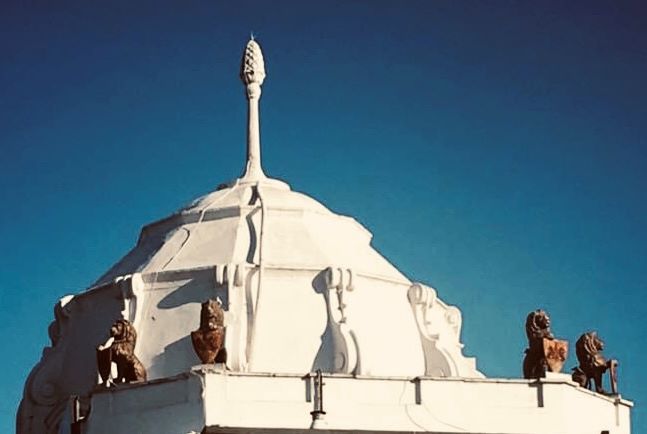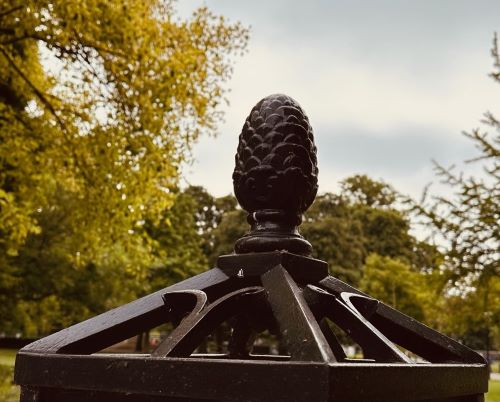by Martin Brisland.
Have you ever wondered why there is a pineapple at the top of the gatehouse to the Royal Pier?
A golden pineapple sits on top of Southampton’s ornate Royal Pier entrance building. In fact, once you start noticing them you will see them on street railings, rooftops, gateposts, monuments and even tombs. There are several on Southampton Cenotaph. Two are on the gates to Watts Park by the Grosvenor Square entrance.
The eagle-eyed might also notice that the trophy for the men’s singles at Wimbledon, which dates back to 1887, has a pineapple design which adorns the top of the lid.
Despite a serious fire on the pier in May 1987 and another in 2002 the gatehouse itself survived. It was reopened in 2008 as Kuti’s Restaurant. The Royal Pier itself had finally closed as an entertainment venue on 31st December 1979.
 The current gatehouse dates from 1930 and was nicknamed the ‘wedding cake’ by some when new.
The current gatehouse dates from 1930 and was nicknamed the ‘wedding cake’ by some when new.
It replaced an earlier 1888 gatehouse which was in front of the present building.
The 1888 gatehouse was built when the pier, originally used by ferries and excursion steamers, was redeveloped into a pleasure pier. It is said that the clock from the 1888 gatehouse ended up above the pavilion at the Municipal Golf Course.
There was a tradition where captains in the British navy returning from sea put a pineapple on the gateposts of their home to show that they were back from their travels and ‘at home’ to visitors.
Pineapples have come to symbolise welcome and hospitality.
Some say this dates back to the Italian explorer Christopher Columbus (1451-1506) who was given a pineapple by friendly locals when he arrived in the volcanic island of Guadeloupe on his second voyage to the ‘New World’ in 1493. He completed four Atlantic voyages, the last one in 1502. His landing party ventured inland and found a Carib village.
Outside the huts were freshly gathered vegetables and fruits, one of which was the “anana” that we call the pineapple. Columbus recorded it in his log as looking like a pine cone with the sweet flavour and firmness of an apple.
The pineapple did not have its origin on this island. The Caribs were masters of the dug-out canoe and brought pineapples back with them from the inland basin of Brazil and Paraguay. Soon, the pineapple was widely transplanted and cultivated throughout the islands.
The pineapple’s natural sweetness soon found favour in the royal courts of Europe. Pineapples are best when picked ripe, but a lack of refrigeration meant they would not be easily transported.
It was nearly two centuries later that European gardeners successfully grew a pineapple in a hothouse.
 King Charles II of England posed for an official portrait of him receiving a pineapple showing it had become the symbol of royal privilege. Sir Christopher Wren even included them in St Paul’s Cathedral.
King Charles II of England posed for an official portrait of him receiving a pineapple showing it had become the symbol of royal privilege. Sir Christopher Wren even included them in St Paul’s Cathedral.
You could even rent out a whole pineapple for use as a table centrepiece at a cost of £5k in today’s money! The crowned fruit became the high symbol of social events to show welcome, friendship, and hospitality.
Even today, in some hotels and inns, you will see a pineapple carved outside the establishments. Often in stately homes, a carved pineapple can be found in head-boards, dining rooms, the backs of chairs, on wallpaper, cupboard doors, and woven dining linen.
However, it’s worth noting that an upside down pineapple badge has a completely different meaning today for those seeking sexual encounters.
- In Common is not for profit. We rely on donations from readers to keep the site running. Could you help to support us for as little as 25p a week? Please help us to carry on offering independent grass roots media. Visit: https://www.patreon.com/incommonsoton
You may also like:
Heritage: Eleanor Coade, the remarkable Georgian businesswoman

